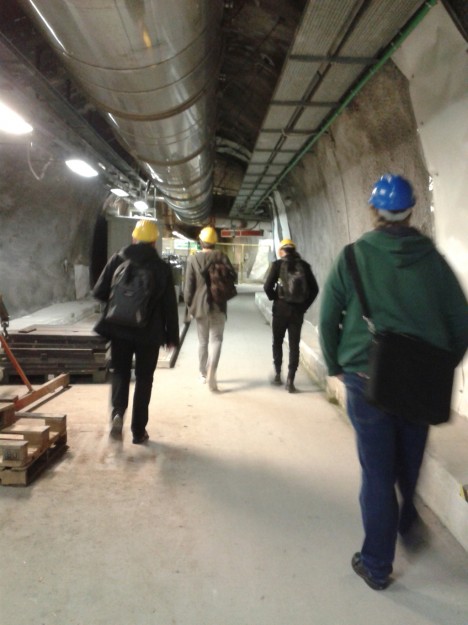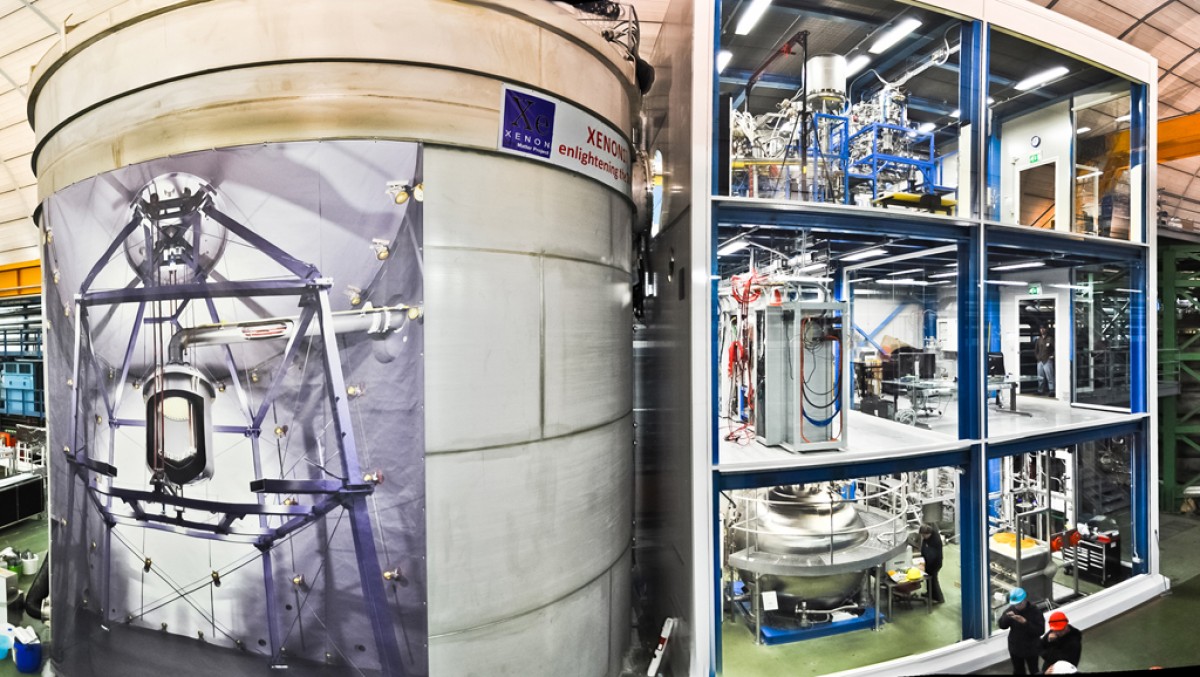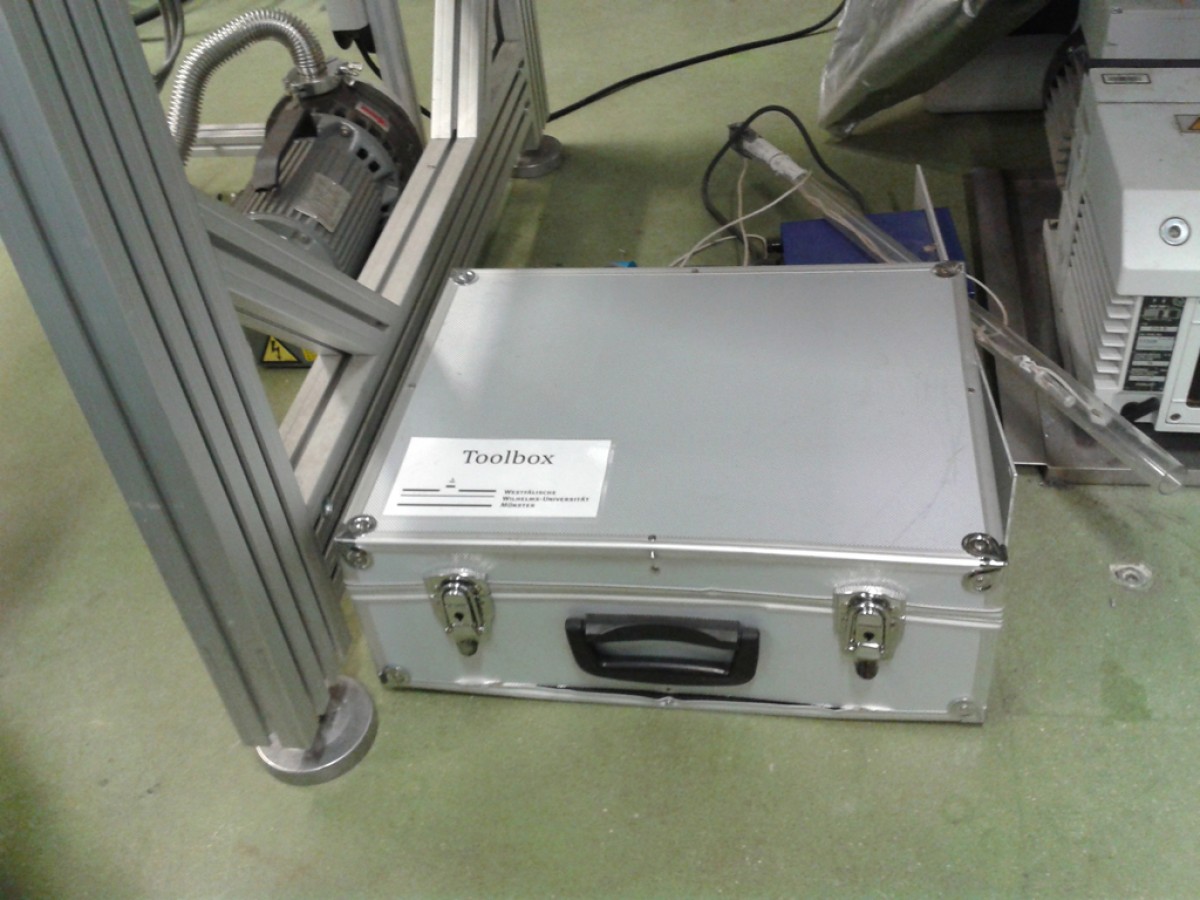
Searching for dark matter
On this spring day there is a clear blue sky over the Gran Sasso mountains in Italy. Prof. Christian Weinheimer from the Institute of Nuclear Physics is sitting in a minibus belonging to the Gran Sasso National Laboratory, accompanied by two PhD students and one post-doc. The minibus is driving north-east along the A24 motorway towards Teramo. Just after Assergi it drives into a tunnel and, after another ten kilometres or so, emerges into the daylight again. Suddenly it does a U-turn, and the driver takes an exit – one not designed for public use – and continues driving along the opposite lane, back into the tunnel. There is a reason for the manoeuvre: the vehicle’s destination lies deep inside the mountains and can only be reached via an exit on the A24 heading towards L’Aquila.
People are attracted to the Gran Sasso mountains in Abruzzo for hiking, climbing and winter sports. The mountains offer unspoilt nature and spectacular panoramas. But there can’t be many tourists who are aware that right in the middle of the Gran Sasso there is a mecca of particle physics. Between L’Aquila and Teramo, about 120 kilometres north-east of Rome, and situated under a layer of rock 1,400 metres thick, is the world’s largest underground laboratory – the Gran Sasso National Laboratory (Laboratori Nazionali del Gran Sasso, LNGS). Around 1,000 scientists from more than 30 countries are working on close to 20 experiments being carried out there. The rock protects the sensitive experiment from cosmic rays.
Among the researchers are Christian Weinheimer, an astroparticle physicist from Münster University, and members of his working group. Along with 120 scientists from all over the world, the Münster physicists are conducting an experiment called "XENON" to look for evidence of the existence of a substance which – to judge from astronomical observations and theoretical predictions – must exist in large quantities in the universe, but which no one has ever set eyes on: dark matter.
Physicists and cosmologists assume that there is five times more dark matter than "normal" matter. Proving this is many a scientist’s life’s work. One such is Prof. Elena Aprile, 62, a physicist from Columbia University in New York. Italian by birth, Aprile heads the XENON experiment and is responsible for the new "XENON1T" detector, costing around 13 million euros, which was inaugurated in November 2015. "This experiment involves hard work and it governs my life," she says. "But it’s fascinating to do cutting edge research – with the most powerful detector of its kind that has ever been developed."
Today the National Institute of Particle Physics in Assergi, a village of 500 inhabitants in the municipality of L’Aquila, is bustling with activity. The scientists involved in the XENON experiment have come together here for a week of conferences. Many of them use the opportunity to take the non-stop minibus shuttle from the LNGS Institute to the underground laboratory just a few kilometres away to complete unfinished work on the particle detector.
Past the security guards – and then down into the underground
Christian Weinheimer and his team have also boarded their minibus at the Institute. After the U-turn on the motorway and a few minutes’ more driving in the tunnel, the driver turns away to the right. The vehicle slows down, takes a narrow road into the mountain and then comes to a stop in front of a steel fire-protection door – at the heavily guarded entrance to the underground laboratory. After security guards have opened the door and waved the minibus through, the scientists get out for an identity check. The next part, into the mountain, is undertaken on foot and with hard hats on.
Underground there are three caverns situated side by side, each about 100 metres long, 20 metres wide and 18 metres high. They are connected by a system of tunnels that covers an area the size of several football pitches. The group of Münster scientists walks past twists and turns highly reminiscent of a labyrinth and then arrives at its destination. At the end of one tunnel a gigantic cavern opens up before them to their left. In the middle of the cavern there is a brightly-lit three-storey building with a glass front and massive nitrogen tanks in front of it. Behind, there is an even larger water tank, ten metres in diameter and ten metres high. Inside this is the heart of the XENON experiment – the highly sensitive detector designed to prove the existence of dark matter particles. The water is a further protective shield against ionising radiation, which interferes with measurements.
The structure serves to detect so-called WIMPs ("Weakly Interacting Massive Particles"). To these hypothetically predicted particles scientists ascribe properties which correspond perfectly to dark matter. "WIMPs are wonderful candidates for being dark matter particles," enthuses Christian Weinheimer – one reason being that these hypothetical particles would have been produced in exactly the right numbers just after Big Bang.
The "XENON1T" experiment will be able to provide evidence of the existence of WIMPs with an unparalleled degree of sensitivity. The technology involved is an upgrade of two previous experiments which had been conducted since 2005. The detector measures collisions between WIMPs and particles of liquid xenon, a noble gas. But there are several snags involved. For one thing, the collisions are very rare – statistically, around two per year can be expected. At the same time – and despite the 1,400-metre rock layer, the water tank and the greatest possible care taken in selecting the building materials to be used – there are still interfering signals underground which the scientists have to distinguish from "real" signals, and that takes a lot of time and effort. Every second the detector registers about one of these "false" signals – which come, for example, from the radioactivity which occurs naturally.
The cryogenic distillation column: unique technology from Münster
One big problem that the scientists had until recently were the traces of a second noble gas, krypton. Certain isotopes of this gas cause interfering signals, but there was no technology available to eliminate them completely from the xenon. "That’s history now," says Christian Weinheimer. "No one here talks about krypton anymore." And he has every reason to be proud of the fact, because it was he and his team who solved the problem. The Münster scientists developed and built a so-called cryogenic distillation column, which can be used to eliminate the krypton traces from the xenon to an unprecedented degree of purity.
This column now stands on the ground floor of the three-storey building, which houses complex technology. Because of its height, the upper part of the column protrudes up into the second floor through a specially made hole in the intermediate ceiling. One member of Christian Weinheimer’s team is using this day in spring to put the final touches to the column. By the summer it will have purified three and a half tonnes of liquid xenon – which is the amount of the gas that the detector works with. In contrast to previous experiments, the scientists are – for the first time – employing more than one tonne of xenon, which explains the "1T" in the name of the experiment, XENON1T.
XENON1T is currently undergoing trials. When all the preparations have been concluded – probably in the summer – work will begin in earnest. That is when the actual measuring activity will start. Will the "xenon family" – as Elena Aprile calls the large community of scientists and junior researchers – be able to provide evidence of the existence of dark matter? Aprile cannot say. "But one thing is clear," she says. "If dark matter really does consist of WIMPs, we have the best possible chances of success here."
CHRISTINA HEIMKEN
This article first appeared in the University newspaper "wissen|leben" No. 4, 22 June 2016.







